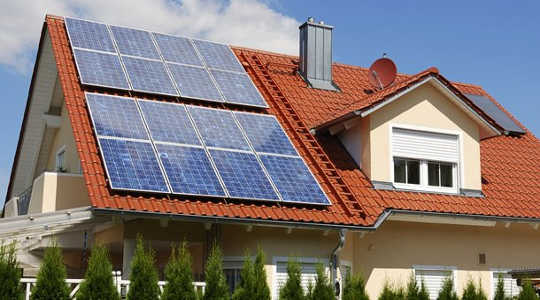
The solar panels of about 40,000 Massachusetts households and community groups cut electricity prices for all of the approximately three million electricity ratepayers in the state, even those without the panels, also called photovoltaics (PV) systems.
“Until now, people have focused on how much was being saved by those who owned PV,” says Robert Kaufmann, professor of Earth and environment at Boston University. “What this analysis quantified was that it actually generates savings for everybody.”
The study looks at how electricity prices and consumption, power plant efficiency, and the capacity utilization of PV systems, are related to one another on an hourly basis.
The paper, published in the journal Energy Policy, notes that using an hourly average for electricity prices, rather than a daily average—as many past studies have done—is a more accurate way to quantify how PV systems affect electricity prices, because such prices fluctuate greatly throughout the day.
There are about one million solar installments—private rooftop, community, and commercial—in the US, and they account for about one percent of the electricity produced in this country. With the cost of PV systems continuing to fall, that number is expected to double in the next two years, according to the Solar Energy Industries Association (SEIA), a nonprofit trade association.
In 1998, the average price of a residential system was $12 per watt; in 2014, it was $4. (The number of watts on a rooftop system varies.) The SEIA ranks Massachusetts sixth among states for solar power generation, as measured by installed solar capacity; the state currently has about 1,020 installed megawatts (MW), enough to power 163,000 homes. Massachusetts Governor Charlie Baker has set a goal of 1,600 installed megawatts for the state by 2020.
Solar power systems save money for all ratepayers because they generate most of their energy during the hot summer months, says Kaufmann, when “everyone has their air conditioners running,” and demand for electricity is at its highest in Massachusetts.
Utility companies, which obtain electricity from a variety of sources, must constantly balance customers’ supply and demand. As demand goes up—say, during the morning hours after people wake up and begin turning on their devices—the companies buy electricity from more and more power plants. They start with plants that can produce electricity most cheaply and move up to more costly plants from there. If demand gets high enough, Kaufmann says, “they have to turn to plants that do not operate very often per year because they’re relatively small, relatively inefficient, and their fuel costs are high” and “that really drives up prices.”
Here’s where solar energy comes in: When a PV system generates electricity, it goes directly into the grid, which is the network of connected power stations and transmission lines that brings electricity to individual customers. Utility companies can use the electricity from PV systems—which is highest in the summer months—rather than turning to those inefficient, more expensive power plants. By not turning on those expensive power plants, each kilowatt hour of electricity generated by PV systems reduces electricity prices by about 1 cent per kilowatt hour. (In 2015, residential customers were charged about 15 cents per kilowatt hour.)
Kaufmann’s study notes that while the price savings that PV systems generate are about the same as the amount that consumers pay to subsidize SRECs, that dynamic will eventually change to the benefit of ratepayers. That’s because once the SREC program ends, sometime between 2020 and 2024, the savings that PV systems generate for all ratepayers will continue throughout the lifetime of each system, which averages 30 years.
“This study is fantastic in pointing out just one of the many benefits of solar energy and how it brings real economic value to all ratepayers,” says Nathan Phelps, program manager of distributed generation regulatory policy for the nonprofit Vote Solar, a California-based non-profit grassroots organization that advocates for solar energy and has offices in Boston. “The economic calculations, as far as total costs and total benefits, can be difficult for many entities, especially state entities, to calculate, because they don’t necessarily have the time or expertise.”
Peter Fox-Penner, director of Boston University’s Institute for Sustainable Energy, a professor of the practice at the Questrom School of Business, and a longtime energy consultant, notes that the customer savings found in the report are even higher for larger-scale community and utility-scale solar plants, without incurring any distribution rate impacts. He points out that a 2015 consulting study he conducted for a large solar firm and the utilities found that large-scale solar plants produced solar electricity at one-half the cost of identical rooftop systems and produced twice the carbon savings per dollar spent on solar.
Kaufmann’s study also shows that PV systems lower greenhouse gas emissions in Massachusetts slightly more than previously thought, a benefit that is also related to solar power’s summertime bonanza. Here’s how that works: Kaufmann says natural gas–powered utility plants are most efficient during the winter months because of the greater difference in temperature between the natural gas fire in the plant furnace and the outside air. The flow of hot air moving from the fire toward the colder outside air creates the power. That power spins the plants’ turbine blades, which generate electricity; the greater the temperature difference, the faster the turbines spin.
But when summer temperatures rise, the flow of hot air weakens. This slows the rotation of the turbine blades, so it takes more fuel to generate each unit of electricity. This results in greater greenhouse gas emissions, but fortunately that is also when solar systems generate the greatest amount of power. Utility companies can make use of solar power and rely less on natural gas plants.
Using a statistical analysis that took into account the fact that PV power generates the greatest amount of electricity when the state’s natural gas power plants are least efficient, Kaufmann’s study estimates that PV systems lower carbon dioxide emissions a little bit more, about 0.3 percent, than what other similar studies have estimated. This is because the earlier studies—while taking into account that PV systems lower emissions when they replace electricity that would otherwise be generated by natural gas plants—did not take into account additional savings from this inverse relationship between PV systems’ summertime energy generation and natural gas power plants’ summertime inefficiency.
Source: Boston University
Related Books
at InnerSelf Market and Amazon
























